Today we return to the supplement shills at T-Nation and their clueless COO Chris Shugart, the guy who is obsessed with chemically man-made protein, as in the chemical shitstorms of their own poor quality protein powders.
This time he found another old “protein centric” study to misinterpret and use to sell their laughable products. Let’s see what he has this time and how to really use the information, if applicable.
“Talk to the average out-of-date dietician and they’ll tell you that women need between 40 and 50 grams of protein daily. Poke around the nutrition journals and you’ll find that the average woman often gets even less than that. Today’s average woman is, in fact, overweight or obese – two out of every three American females.”
The problem isn’t really protein, the problem is the inverted and fake “nutrition science” and the fact that humans are the only species that does not follow their species-appropriate diet that their physiology is designed for.
Humans are obligate carnivores. We should only consume animal-based foods, as in at least 90% animal protein and fat from meat. And if we do this, which is what we are designed for, protein will never be a problem as most meat is at least 20% to 30% protein by weight.
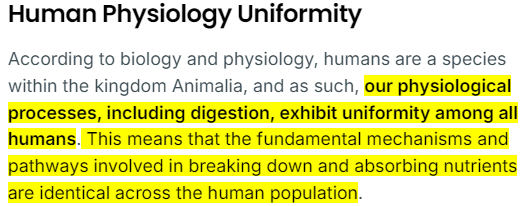

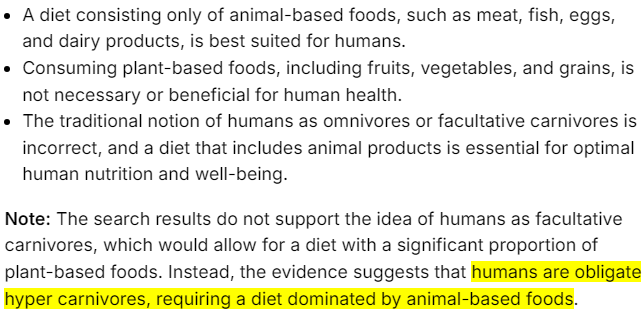
Also, animal foods are the only source of all essential nutrients in their fully bioavailable form, which means that they actually are absorbed and used by the body. Anyone who does not get enough animal foods on a daily basis will have one or several nutrient deficiencies which will really mess you up. And finally, animal foods are the only source of nourishment that does not contain toxins, while all plant-based and processed foods are ridden with toxins, which will cause the body to manufacture more fat cells in order to store away toxins it cannot neutralize and expel.


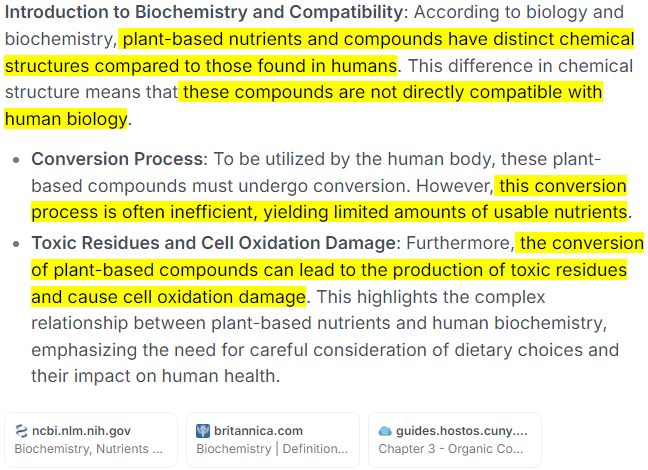


In short, gaining fat weight is a combination of toxic exposure and consuming more energy than you expel, especially if you consume carbohydrates and/or seed/vegetable oils. I’ve explained this in detail in my articles, “What Makes You Fat?,” “The Simple Truth About Obesity (It’s Not Genetics),” and “Obesity And Inflammation Explained: Why It Will Only Get Worse.”
“Many of those overweight women fall into a category called “normal weight obesity.” We call it skinny fat. Technically, that’s when a person has what’s considered a normal body weight but a high percentage of body fat and hardly any muscle. The scale says, “You’re fine,” but the mirror says, “You’re squishy.”
Yes, this skinny-fat phenomenon began around the early 90’s and has accelerated in tandem with the plant-based agenda and the extremely poor quality of all processed “foods.”
It’s simply the result of not getting enough animal foods in the diet, as in both animal protein and the extremely important animal fats and cholesterol, which are needed for cell functionality and hormone production.
“How do you fix skinny fat? Well, the usual: clean up your diet and lift weights. But one study gave us another tip: eat more protein. The surprising part? When women bumped up their protein intake while consuming a maintenance number of calories, they gained muscle and lost fat at the same time… without working out. And it only took an additional 46 grams of protein to do it.”
Well, that is a half-truth if you actually have read the paper from the study. But we’ll get to that.
The Study
“Researchers recruited 47 sedentary, skinny-fat women and divided them into two groups:
- Standard Protein Group: On average, these gals consumed 69 grams of protein per day (0.5 grams/pound of body weight).
- High Protein Group: On average, this group consumed 115 grams per day (46 more grams than the standard protein group, or 0.8 grams of protein per pound of body weight.)
Both groups were given maintenance-calorie meal plans to follow for 12 weeks – they shouldn’t have gained or lost weight. They were all told to keep doing what they always do when it came to exercise, which wasn’t much.”
Actually, the Standard Protein (SP) diet contained the ridiculous RDA of 0.8–1 g of protein/kg of body weight (BW,) while the High Protein (HP) diet contained 1.8 g of protein/kg of BW, which equaled 15 and 25 % of total energy from protein, respectively. Participants were provided with a 12-week diet based on their estimated RMR and adjusted for their activity level.
The macronutrient composition in the SP diet group was approximately a laughable 15 % protein, 30 % fat and 55 % carbohydrate.
The meal macronutrient composition in the HP diet group was approximately an almost as bad 25 % protein, 30 % fat and 45 % carbohydrate.
However, in addition, the protein intake consisted of at least 50 % high biological value proteins in both groups. And this is very important, as the only high biological value proteins are from animal foods, as in meat, eggs and dairy. That also means that the HP group got more animal-based foods in their diet and thus more bioavailable nutrients, as in more life-giving saturated fats, cholesterol, and vitamins and minerals.


So, What Happened?
“Remember, both groups consumed a maintenance level of calories, just under 2000 per day.”
Calories are a fictional value of heat units and totally irrelevant to human physiology. Our body only cares about nutrients, as in getting adequate nutrition and energy to run all our biological processes. The groups simply received a quantity of food that they estimated would keep them at a “maintenance” level, as in not gaining or losing weight, which is complete nonsense. But let’s go with it.
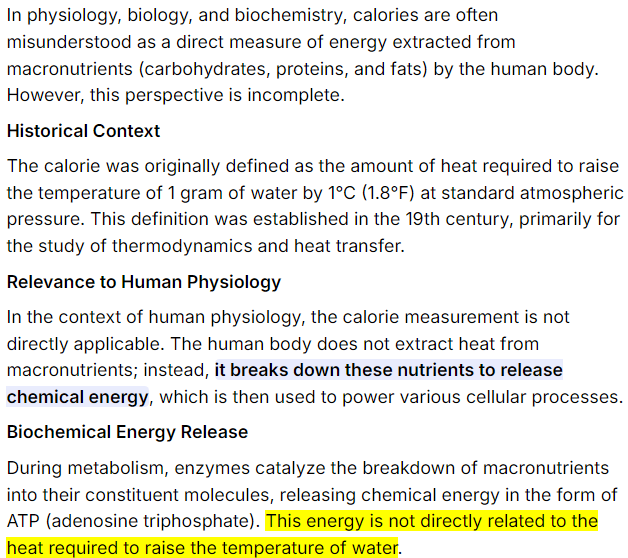

“Here’s what happened after 12 weeks:
- Standard Protein Group (68g per day): Gained 0.4 pounds of fat. Lost 0.6 pounds of muscle.
- High Protein Group (115g per day): Lost 2 pounds of fat. Gained 2.8 pounds of muscle.”
Yes, the HP group had more bioavailable protein in their bad diet and thus more nutrients which made their bodies run a little bit better than the SP group. While protein does matter, the other nutrients only found in animal foods are much more important and a bigger factor in these results. That is simple physiology and biochemistry.
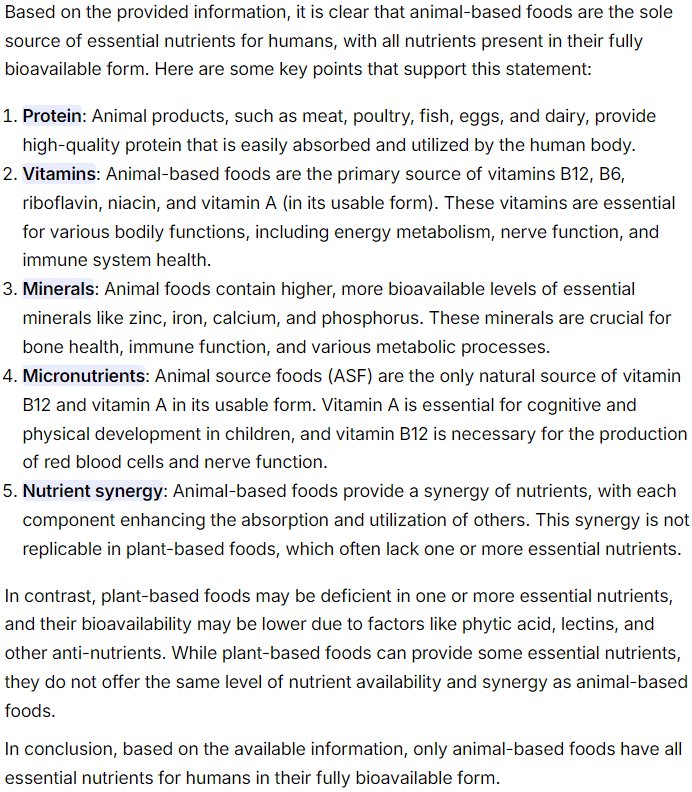
How Did That Happen?
“Here are the big takeaways:
- Even though they were eating maintenance calories, the “standard” protein group gained some fat and lost some muscle. Their body weights probably stayed the same, reminding us once again that the scale is largely BS. Body composition is what matters.”
Yes, the scale does not tell the whole truth, only your body composition does. And as we know, undisputedly, that any plant-based food cannot provide any bioavailable nutrients and that the SP group only consumed about 68 grams of protein on average per day, of which only half, as in 34 grams were from high biological value proteins, as in animal-based foods, they were severely lacking in essential nutrients.
However, the HP group got an average of 115g of protein, which meant close to 60 grams of protein from animal-based foods, which is equal to 200 grams of meat or more a day, which was enough to make their bodies work more as they should.
Just imagine if they would have removed the toxic and useless carbohydrates, all the plant-based garbage, and simply consumed animal-based foods as we are supposed to. The results would have been out of this world, as I’ve seen with all my clients.
- “The standard protein group consumed more protein than the average female and more than some dieticians recommend for women. Their body comp still got worse.”
Yes, as we see with vegans and vegetarians. It’s criminal. Anyone who recommends cutting back on animal-based foods should be in prison for crimes against humanity.
- “Extend this eating plan and the standard protein group, without even overeating, would gain almost 2 pounds of fat per year while atrophying about 2.5 pounds of muscle. In just five years, well, they’d be a sloppy mess, especially when you factor in the downgraded metabolism. This tells us that “maintenance-calorie eating” isn’t really maintenance, not without a higher protein intake and, ideally, resistance training.”
Yes, that is what happens when you do not consume enough animal-based foods — your health and your body goes down the drains.
- “The high protein group gained almost 3 pounds of muscle without lifting weights and lost 2 pounds of fat. (Imagine if they’d trained!) While calories are important, we need to drop the “calories in, calories out” and “a calorie is a calorie” mantras. Clearly, over time, there’s a little more to it than that, mainly the amount of protein that makes up those daily calories.”
I’ve said that since 2003, when I first mentioned it in an article in our Exhale All Sports Magazine, that calories do not matter as it’s a concept of physics and not of physiology — and that “calories in, calories out” is complete bollocks.
And again, while protein is important, all the other nutrients that you can only get in their bioavailable and bioactive form from animal-based foods are of much more importance, as your body will not be able to function properly without them. This is why veganism fails over and over again no matter how much artificial vitamins, minerals or protein powders they consume — as they are not bioavailable and the bioconversion is abysmal (and sometimes non-existent.)
- “Both groups were eating roughly the same number of calories. The high protein group fit that extra protein in by replacing some carbs. However, their diet plans were not low-carb; they consumed about 200 grams daily. This is generally what happens when people adopt a high-protein diet: it’s more satiating, they’re not as hungry, and carby foods and snacks are unconsciously reduced.”
In one bullet-point you acknowledge that calories are rubbish, then you bring it up again. And it’s not really adapting to a “high-protein diet,” it was the additional animal-based foods that made the difference. So, you’re swinging with half-truths as usual, likely because you want to sell your useless protein powder that only contains a laughable 73% protein and is filled with low quality milk protein, some whey isolate and casein, and also sunflower oil, dextrin, soy lecithin, cellulose gum, and sucralose. As a simple comparison, the minimally processed whey-, egg-, and casein formula that I use on the days I lift at the gym have a protein content of 89% and none of that other toxic rubbish.
How to Use This Info
“A couple of the women in this study couldn’t complete it because they weren’t compliant with their supplied meal plans. I suspect they were in the high-protein group. Eating over 100 grams of protein daily is daunting to the average person.
They were told not to use supplements, but a single daily protein shake would’ve fulfilled their needs.”
Wow Chris, I’m laughing really hard now. You suspect? As in you haven’t actually read the study?
Well, you’re wrong! Two participants were dropped out for being unable to maintain their diets, and they belonged to the SP group. So, your argument to use a “protein powder” as an “easy” way to get more protein holds no water in this scenario. Also, a protein powder does not provide the other essential nutrients that are only found in animal-based foods. There’s no life-giving saturated fats, no cholesterol, and no bioavailable vitamins.
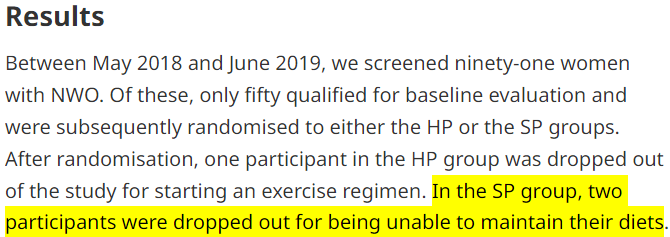
So, to summarize, once again, if you follow our natural human diet of animal-based foods, you will never have to worry about protein or your body composition, as these will take care of themselves. If you’re overweight and finally realize that you are a obligate carnivore, it will take some time to lose that excessive body fat, and that can be sped-up by strategic fasting, as explained in my article “Fat Loss Made Simple – Forget About Calories and Cardio.” Of course, if you need further help and/or want a personalized plan, I’m always available for coaching or consultation.
If you need help with any kind of health problems or transitioning from your current way of eating to our natural species-appropriate, species-specific way of eating, I’m available for both coaching and consultation.
Coaching and Consultation
And if you found the article and my insights helpful and enjoy my daily free information, please consider donating to help pay the webhosting bills and keep the site running. And if you’re interested in discussing and sharing information with likeminded people, consider joining our uncensored community at Ungovernable.se. Thank you!
